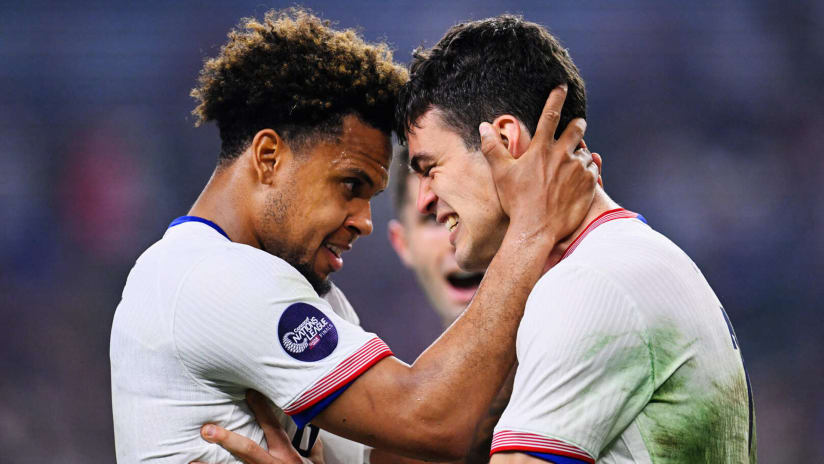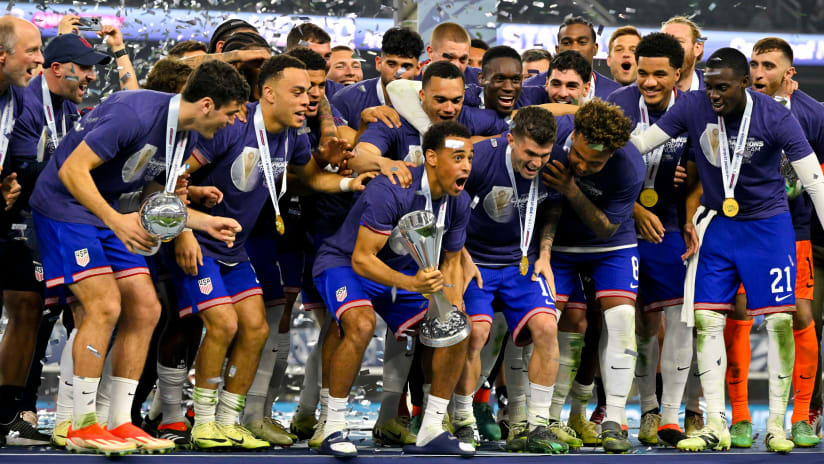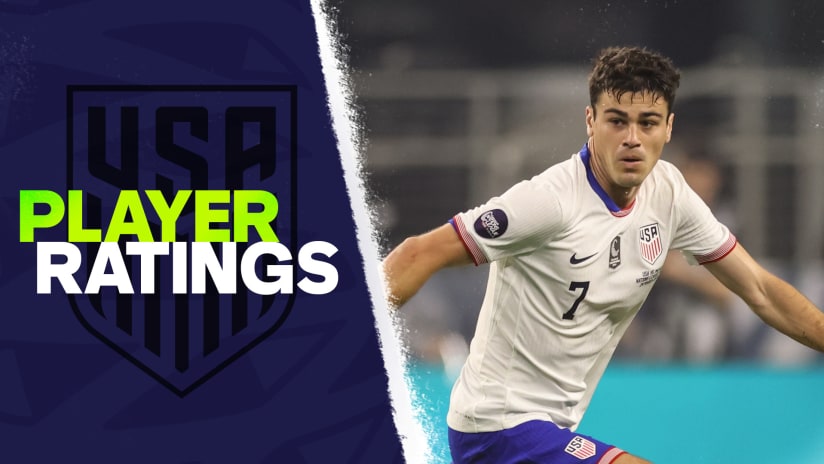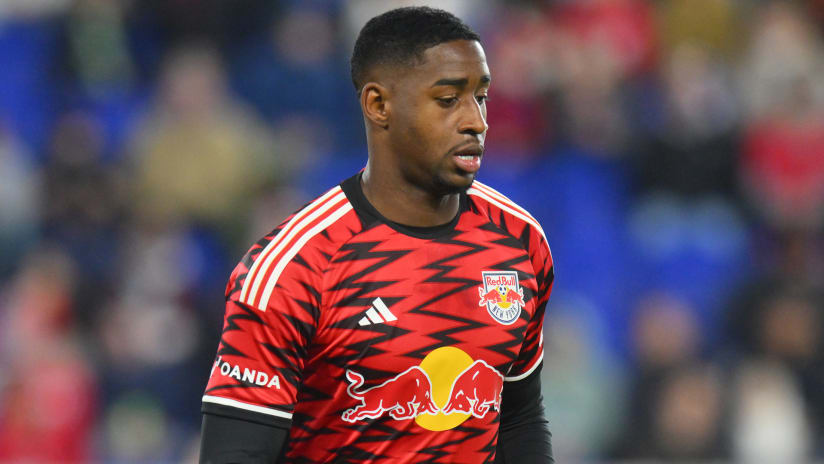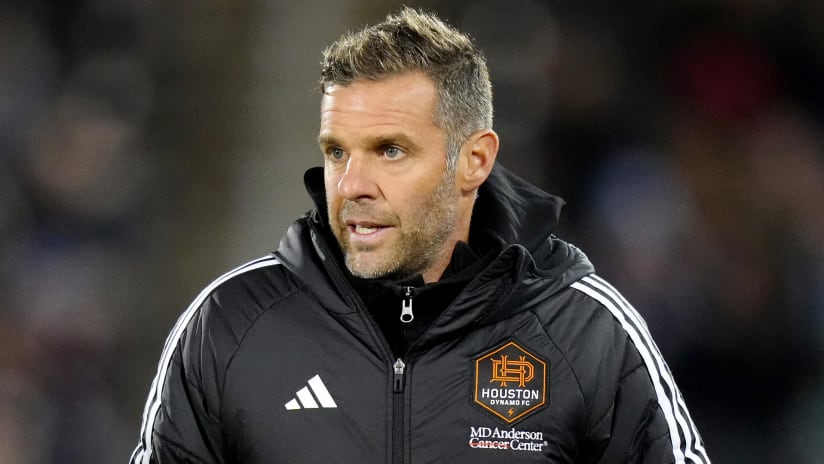In their first World Cup appearance in 40 years, way back in 1990, the United States men's national soccer team looked drastically different than the Yanks of today. Six - soon to be seven - World Cups later the Americans will line up with a system that is a byproduct of global tactical shifts and pure American soccer self-actualization. Here's how they got there.
USA 0 - 1 ITALY | WORLD CUP 1990
After Czechoslovakia delivered the Americans an embarrassing 5-1 evisceration in the first match of the 1990 World Cup, nobody could blame head coach Bob Gansler for lining up a more conservative formation in the following match. Favored over attacker Eric Wynalda, who was serving a suspension after a 52nd minute red card against the Czechs, Marcelo Balboa was inserted into the defensive midfield in what proved to be a vintage "stopper" role.
Note: These graphs represent the average event positions of each player while the lines represent the volume of successful passes that each pair exchanged between them. This data was collected by Opta, and their collection of detailed World Cup data spans back to 1966.
While Balboa didn't exactly operate as the midfield shutter that we're familiar with in modern soccer, he did occupy the space between the defense and the midfield that the Americans had conceded so liberally in the first match. In an age in which teams' width was provided almost exclusively by midfielders, the stopper provided the same sort of support structure that modern outside backs provide today - a platform for the more creative players to operate directly ahead of them.
To put it simply: a defensive-minded tactical shift allowed for more cohesive and confident attack.
Balboa's presence pushed the attacking Americans further up the pitch while at the same time pushing the team forward a half-decade tactically. With this newfound space, current Sporting Kansas City manager Peter Vermes - remember, he was a forward then, folks - nearly bagged a goal against former New England Revolution goalkeeper Walter Zenga.
That goal, which would have changed a 1-0 loss to an impossible 1-1 draw vs. the hosts, could have drastically changed the narratives coming out of that tournament. Even without the equalizer, however, plenty had changed for the US.
USA 1 - 1 SWITZERLAND | WORLD CUP 1994
Quickly graduating from curious side-show attraction to a welcoming host, the United States played home to the 1994 tournament. While Gansler deserves credit for correctly inserting (and sticking with) a "stopper" in 1990, the Americans needed a more proactive tactical direction. That direction came in the form of Bora Milutinovic, who quickly moved the Americans from the 3-5-2 of yesteryear to an in vogue 4-4-2.
With Balboa retreating into a proper center back role alongside Alexi Lalas, bookended by outside backs that resembled a more conservative version of today's attacking fullbacks, the American defense was sturdy from the first kick.
Bora also planted Mike Sorber into the defensive midfield role, but Sorber's proactive responsibilities contrasted starkly against Balboa's reactive deployment in 1990. Balboa was tasked with destroying the deep midfield while Sorber was tasked with utilizing it. Connecting five or more passes between himself and eight other American outfielders against Switzerland, utilize it he did.
USA 1 - 2 IRAN | WORLD CUP 1998
The three-and-out performance at the 1998 World Cup in France isn't something that American soccer fans remember fondly, but it did feature one of the more intriguing experiments in American soccer tactics. Stepping back from Bora's four-man backline, new US coach Steve Sampson reverted to a three-man defensive contingent that is considered a failure given the disappointing results.
However, Sampson did open the US up to the world of fleet-footed wide players, flanking the defenders in an undoubtedly progressive tactical bent. While Frankie Hejduk wasn't exactly Dani Alves, he was a genuine wingback.
Step back for a moment and compare this 3-5-2 to the 3-5-2 against Italy in 1990 (Yes, the US played a 3-5-2 against Iran - Wegerle was the second striker. The infamous 3-6-1 was scrapped after the opening game vs. Germany).
Eight years after learning that the United States required defensive help in the deep midfield, and four years after Bora proactively deployed Sorber into the defensive midfield, Sampson left the defensive midfield entirely naked in 1998. Opting for that much more attacking central midfield troupe proved to be Sampson's undoing, as the Americans conceded first half goals in each of the three group stage matches and scored just once themselves - total.
Each game desperately calling for a midfielder operating deep and between the lines.
USA 2 - 0 MEXICO | WORLD CUP 2002
Enter Bruce Arena, the all-time winningest coach in US history. What does Bruce do in the first match of the 2002 World Cup? He slots Pablo Mastroeni into the defensive midfield and earns what is ultimately the only group stage victory for the United States in the competition.
Yet Arena opted away from Pablo and a dedicated defensive midfielder in the remaining two group stage matches. This resulted in the Americans barely limping out of Group D with a 1-1 draw against South Korea and then a 3-1 loss to Poland in the group finale.
Bruce learned from his mistake and reinserted Mastroeni versus Mexico in the first match of the knockout stage.
Did the United States complete many passes? No. But the US weren't trying to win a possession duel, they were trying to win a soccer game. Arena didn't expect much possession against the Mexican squad that had just won their group over the likes of Italy, Croatia and Ecuador - El Tri were, and still are, a superior possession team.
The way to win, then, was to turn their possession into useless possession. At that the US excelled, holding Mexico to a single shot on goal - after a flub from goalkeeper Brad Friedel, no less.
Mastroeni was the key, forcing Mexican attackers wide. With two superior defensive wingbacks out there (Claudio Reyna on the right, Eddie Lewis on the left) and two active central midfielders in John O'Brien and Landon Donovan joining in Mastroeni's harrying, Mexico created plenty of possession but no danger. And when they lost possession, it was off to the races for the US.
The most important Dos a Cero in soccer history may have been sealed with a Donovan breakaway in the second half, but it was brought to you by the American defensive midfield.
USA 0 - 3 CZECH REPUBLIC | WORLD CUP 2006
2006 was a different kind of learning experience for the Americans. Arena, like the American coaches before him, had finally embraced just how much a solid defensive midfielder meant to the American system - so much that, for the first time, the Americans deployed two midfielders directly in front of the back four. Mastroeni returned and this time was partnered with Reyna.
This partnership was less than fruitful.
While Reyna was the ball circulatory heartbeat of the team, playing him deeper ended up robbing the US of much of their danger. Similar to what Mexico learned against the United States in 2002, the Americans quickly found that possession without penetration was unfulfilling.
Handicapping your own defensive midfield proved just as ineffective as ignoring it all together. Herein lies the cautionary tale for the expected Michael Bradley / Jermaine Jones midfield duo in Brazil 2014. Kyle Beckerman isn't as good of a player as Jones, but his inclusion could provide a platform for the attack just as Mastroeni, Sorber and Balboa before him.
USA 1 - 1 ENGLAND | WORLD CUP 2010
In perhaps the most famous draw in American soccer history, we also saw the World Cup debut of Bob Bradley's immensely narrow 4-4-2, often called a 4-2-2-2 or even (semi-)jokingly referred to as the "Empty Bucket" formation.
The bucket was the gaping hole between Michael Bradley and strikers Jozy Altidore and Robbie Findley. Neither Donovan nor Clint Dempsey occupied that space exclusively, both drifting in and out depending on the phase of play. Donovan, often wide on the break, pulled Dempsey into this hole - temporarily filling the bucket - as if they were operating in a vacuum on Landon's stoppage time goal against Algeria.
For the US, starting off group play vs. heavily favored England, the two-man defensive midfield looked much the same on paper as it had in 2006, but it was implemented much differently. Both Michael Bradley and Ricardo Clark (later Maurice Edu) played defense first, with the more dangerous Bradley venturing only slightly ahead during defense-to-attack transition.
Coach Bradley had accepted the central tenent of the emerging American soccer style of securing the defensive midfield while providing a springboard for a ruthless counterattack.
But the coach's moves weren't perfect, and against Slovenia in the second game he erred on the side of possession by introducing a more technical Jose Francisco Torres. It's of little surprise that when Bradley exchanged Edu for Torres with one of his trademark 46th minute substitutions, the game slid in favor of the Americans dramatically.
WORLD CUP 2014
Every coach of the United States men's national team since at least 1990 has grappled with the defensive midfield conundrum. The Americans' inability to perform without a solid and dedicated defensive midfielder is a trend that has persisted for a quarter century over multiple generations without an obvious reason.
One suggested explanation for the American dependence on a pure d-mid is a perceived lack of international caliber two-way midfielders. That's easily dismissed, especially given how much the 2002 team struggled when Reyna and O'Brien - possessed of skill and tactical nous on both sides of the ball - were paired without Mastroeni shielding. Michael Bradley and Thomas Dooley are the other outstanding two-way central midfielders in the US timeline, and both played better next to (or in front of) a destroyer.
It's a lesson hard-won over the last 25 years. Let's hope that Jurgen Klinsmann has become a true student of US soccer history - lest he be doomed to repeat it.


